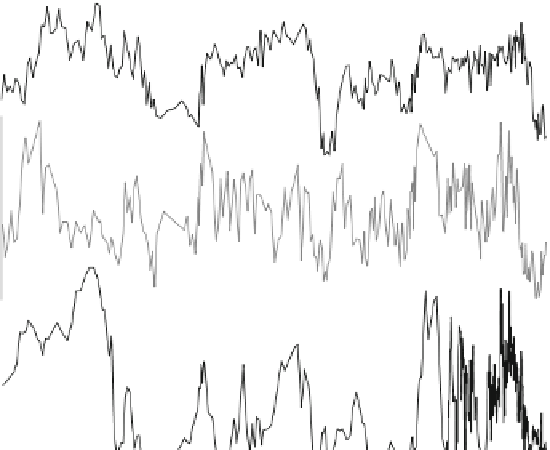Geoscience Reference
In-Depth Information
Age (kyr BP)
Fig. 17.6
Proxy records from core MD962094. Top: •
18
O record showing glacial-interglacial
swings throughout the last 300 kyr BP. Middle: wind-driven carbonate dissolution record.
Bottom
:
wind strength record, as reconstructed from the dust fraction (Redrawn from Stuut et al.
2002a
;
b
)
Weltje and Prins
2003
). Generally, throughout the Pleistocene, glacial periods were
characterised by intensified atmospheric circulation due to increased latitudinal
pressure gradients. These increased winds are often reflected in larger wind-blown
particles. Presently, there are still lively discussions on the size of dust particles
and how far they can be transported through the air, but the intuitively logical
downwind decrease in both dust flux and particle size was beautifully demonstrated
by Sarnthein et al. (
1981
) for the Saharan dust plume (Fig.
17.5
).
The southeast Atlantic Ocean, offshore Namibia, is dominated by the trade wind-
driven upwelling of deep waters, causing high primary productivity in the surface
ocean. These same trade winds also carry dust from the Namib Desert, which
settles on the sea floor. Stuut and co-workers demonstrated how the variability of
the trade wind system varied throughout the late Quaternary based on the particle-
size distributions of both the marine sediment fraction (Stuut et al.
2002a
)andthe
land-derived sediment fraction (Stuut et al.
2002b
). Generally, during glacial stages
of the late Quaternary, atmospheric circulation intensified, leading to enhanced
wind-driven upwelling, which is reflected in the particle size of the carbonate
fraction. As the upwelled waters are cold, they are more corrosive to carbonate
tests of unicellular plankton and will consequently influence their particle size.
Simultaneously, the intensified winds had a larger carrying capacity, which enabled
them to carry coarser-grained dust particles (Fig.
17.6
).



























































Search WWH ::

Custom Search